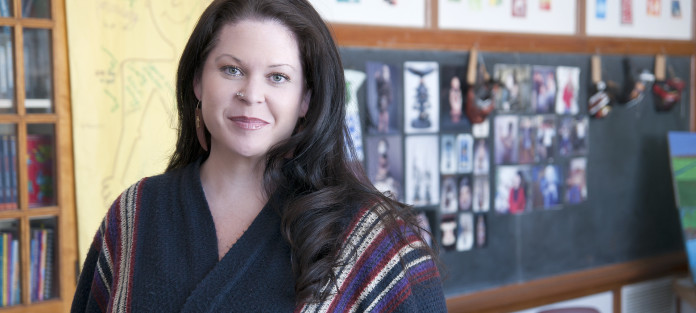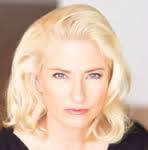Amy Hewett-Olatunde teaches English as a Second Language to both high-school and college students in St. Paul.
When someone asks Amy Hewett what she does for a living, “Sometimes I just say, ‘I’m a teacher.’ Other times I have to explain it more.” Since 1999, Hewett has been a full-time teacher of English as a Second Language (ESL) at LEAP High School in St. Paul. She also teaches at Hamline University, working with international students and “generation 1.5 students” – those who have been in the U.S. for several years but who weren’t born here and who are the first generation to go to college. She supervises second-licensure student teachers through Hamline’s graduate ESL program. Finally, she teaches linguistics and second language acquisition in the University of St. Thomas graduate ESL program.
“It’s the life of an adjunct,” Hewett concluded.
Hewett graduated from Concordia College in Moorhead, Minn., with a degree in Scandinavian Studies and German Secondary Education. She took “a really bad job” with a company in the Twin Cities and started volunteering at the International Kids Club, a program for elementary students and their parents in Bloomington. “I remember one night in my first week, looking up at the sky. The heavens literally opened up. The next day I quit my job, applied for the ESL program at Hamline, and everything completely changed,” she recalled.
She did her student teaching at LEAP and “never left,” she said. “Every day I go to work, I feel blessed and honored to be with my students. They’re motivated, they’re disciplined. They come from places where they were denied education. When you’re teaching them, they really want to be with you. Every semester I say I’m never going to be with a better group of students, but every semester a new group comes in and I fall in love with them,” she said.
Why was ESL such a good fit for you?
I kind of think it’s because of the upbringing I had. We always had exchange students staying with us, from Thailand and all over the world. My mother would read to me a lot, expose me to stories from different cultures.
Have the ESL populations changed since 1999?
When I started at LEAP, we mostly saw East African students – Somali, Oromo. We also had a pretty good population of Latino students. After 9/11 we didn’t get a lot of East Africans. We saw more Latino students. In the spring of 2004, we got word that there was going to be a huge number of Hmong coming from a refugee camp in Thailand. It was a super-exciting time. The majority stayed through their whole education. They did really, really well. Today LEAP has students from 26 different countries. About 60 percent are Karen refugees from Burma. There’s also been an influx of Nepali from refugee camps in Bhutan. Whatever is happening in the world, we see at our door.
What are the challenges of your job?
Because I teach poetry, the narratives that come out are very heavy. A lot of times I bring that home with me. I internalize it. I’m always thinking, as a mother myself, how I would want my child educated.
Is there a demand for ESL teachers?
I can’t give you specific numbers but the student teachers I supervise all have jobs. When you get an ESL license, it’s K-12 and you can work also with adults. It opens a few more doors than when you get a license that’s just for high school or middle school.
Photo Credit: Tom Witta
Link: http://www.startribune.com/my-job-amy-hewett-olatunde-english-as-a-second-language-teacher/251940251/











